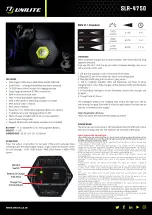
6. Assessment of safety integrity
General
6.1.
The safety-related device has been designed based on DIN EN 61508-6 for 1001 architecture and demon-
strates a hardware fault tolerance of NIL as per DIN EN 61508-2. Limitations to safety integrity based on the
architecture are accounted for based on the classification as a type B subsystem.
Independent of the safety integrated, the device possesses an MTTF(d) of more than 100 years. Note that the
contact set for the fault indicator relay is not accounted for in the calculation. When determining the life cycle,
the B10d specifications from the manufacturer based on the contact load and the frequency of operation are
decisive, see Table 1 - B10d values for the Schrack SR2M V23047-A1006-A511 safety
relay
.
The following B10d values must be taken into account during system integration:
2.9
B
10d
values
for safety-related control systems of machinery
Dangerous Failure mode:
Failure to open of a relay contact or insulation failure
AC1
Ue = 250V; T
AMB
+ 70°C
2.9.1
Ie = 6 A; 1 NO
2.9.2
Ie = 3 A; 1 NO
2.9.3
Ie = 1.5 A; 1 NO
AC15
Ue = 250V
2.9.4
Ie = 3 A; 1 NO
2.9.5
Ie = 2 A; 1 NO
2.9.6
Ie = 0.75 A; 1 NO
DC13
Ue = 24V
2.9.7
Ie = 3 A; 1 NO
2.9.8
Ie = 1.5 A; 1 NO
2.9.9
Ie = 0.75 A; 1 NO
Confidence level for all B
10d
values 50%
600,000 cycles
900,000 cycles
1,800,000 cycles
180,000 cycles
560,000 cycles
4,600,000 cycles
360,000 cycles
740,000 cycles
4,200,000 cycles
Product data, technical parameters, test conditions and processing information only to be used together with the ‘Definitions’ section at
http://www.te.com/commerce/DocumentDelivery/DDEController?Action=showdoc&DocId=SpecifOr+Standard%7FDefinitions_Relays%7F1117%7Fpdf%7FEnglish%7FENG_SS_D
efinitions_Relays_1117.pdf%7F6-1415011-1
© 2015 TE Connectivity Ltd. family of companies. All Rights Reserved
Table 1 - B10d values for the Schrack SR2M V23047-A1006-A511 safety relay
Request modes
6.2.
The safety-related device is suitable for requests in both low demand mode and high demand mode. Compli-
ance with the framework conditions associated with these request modes (as per DIN EN 61508-4) is the re-
sponsibility of the higher-level, safety-related control and guidance systems.
Operating modes
6.3.
Based on the select architectural concept, the safety-relevant device can be integrated in a variety of ways into
the higher-level safety-related control and guidance system. Integration can be recoded in two topologies:
1) Generation of the optical warning signal as a safety function
•
Request for the safety function without additional assessment of the monitoring function
•
Request for the safety function with parallel assessment of the output of the monitoring function
•
Request for the safety function with parallel assessment of the output of the monitoring function and pri-
or test of the monitoring function. The test of the monitoring function must be performed prior to the re-
quest for the generation of the optical warning signal as a safety function.
2) Monitoring of the safety function
•
Request for the monitoring function as a safety function without prior test of the monitoring function
•
Request for the monitoring function as a safety function with prior test of the monitoring function. The
test of the monitoring function must be performed prior to the request for the monitoring function as a
safety function.
The operating behavior of the monitoring function and the sequence for the test of monitoring function is de-
scribed in chapter 7.
085501100
page
5 /16
30401 – 004-2












































